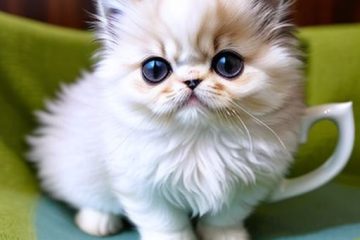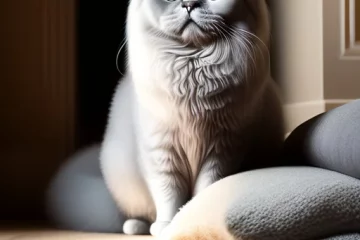Persian cats are some of the most fascinating creatures in the world. Despite their mesmerizing appearance, they’re just as much like other felines as they are different, though you might not be able to tell just by looking at them.
This article looks at the differences between Persian cats and normal cats so that you can better understand the breed, even if you do not own one!
What is the difference between a Persian Cat and a Normal Cat?
Persian cats can be distinguished from normal cats in many ways. The most common way is to compare them based on their face shape.
Persians have much longer muzzles than normal cats, with rounder faces. Their eyes are also further apart, and their whiskers are placed closer to each other.
Normal cats have shorter muzzles, flatter faces, large eyes, and widely spaced whiskers. Another difference between these two types of cats is that Persians have very long hair, while normal cats do not.
This makes it easier to distinguish between these two types of cats. They may look similar, but they are very different in appearance as well as personality.
A normal cat will eat anything you give him or her, even if it isn’t food. He or she will beg for food all day until he or she gets some sort of meal. A Persian, on the other hand, doesn’t beg for food at all; he or she will only eat when hungry.
What makes Persian cats unique?
Characteristics that make Persians different than other cats include their long, flowing coats, which require daily brushing to prevent tangles and mats.
If you’re willing to put in these regular grooming sessions, you can enjoy all of your cat’s unique characteristics. For example, Persians have large eyes and round faces, with shorter noses than many other breeds.
Their ears are also very large—and they come in a variety of colors! The American Kennel Club recognizes two types of Persian cats: traditional style (long hair) and modern style (shorter hair).
Both types are generally healthy but may be more susceptible to specific health problems such as heart disease or respiratory issues. However, proper care can help keep them healthy for many years to come!
Do Persians typically come in different colors?
Yes. Although Persians are, in general, one solid color, many come in different variations of that color. Some examples include seal-point (black mask on the nose), blue-cream (blue coat with cream undercoat), red tabby-white (orange coat with a white undercoat and red markings on face), etc.
If you’re looking for a particular look for your cat, chances are there is an existing variation of it out there! Of course, if you want something specific or can’t find what you’re looking for, breeders will be more than happy to create a custom breed to suit your needs!
You could have cats that are combinations of many different breeds; as long as they have at least 50% Persian blood in them, they will still be considered Persians by breeders.
Do Persians need special care than other cats?
Yes! Persians require more care than other cats because they have fewer teeth than non-Persians. This means that their saliva doesn’t break down food as well, which makes them prone to gum disease.
Make sure you brush your Persian daily with a soft toothbrush or a special cat toothbrush. You can also give him chew toys to help clean his teeth.
If he gets an upset stomach, make sure you rush him to the vet right away so he can get treated for it! He will be just fine if you take good care of him, but if you don’t, you could lose him forever!
The best breed to mix with Persian cats
There’s nothing wrong with getting a Persian cat mix. If you’re looking for what kind of cat mix would best suit your Persian cat, check out these suggestions.
The Bengal, which has a medium to the long hair coat, is probably one of the most popular hybrid mixes available today. With his exotic look, he will certainly turn heads wherever you go. Another great choice is a Maine Coon mix, which combines beautiful faces with a soft temperament.
These cats are known for their intelligence and playful nature. Contact local breeders or pet stores in your area for more information on different breeds that could work well with your Persian cat.
Also, remember that many shelters and rescues also offer a variety of other cats from which you can choose.
Most importantly, remember that no matter what kind of cat you decide on—or if you decide to stick with your purebred Persian—there is no such thing as an inferior type of cat. All cats have unique qualities and make excellent companions!
How can you tell if your feline is a Persian cat?
The best way to tell if your kitty is a Persian cat is to examine his physical appearance. Persian cats are extremely fluffy with lots of furs.
So if your cat is cute but not poofy or fluffy, it’s most likely not a Persian cat. Additionally, many breeders look for ears that are ‘velvety’ or soft in texture — if your cat has these types of ears, then he may be a Persian cat.
Other breeds have very short hair (like siamese cats), while others have long hair (like longhaired cats). If you want to know whether your cat is a Persian cat, just ask! Breeders will be able to help you determine whether your kitty is indeed a Persian cat.
You can also take a look at his paws: Persians tend to have longer paw pads than other cats, although there are exceptions.
Be aware that some people call all furry cats Persians; if you aren’t sure whether or not your cat is actually a Persian cat, do some research on its pedigree before you decide!
It would be very unusual for an ordinary domestic shorthair cat to be referred to as a Persian.
Can Persian cats be house cats?
The general answer is yes; most cat breeds can live happily in homes. However, there are some breeds that were specifically bred to survive outdoors.
If you’re an outdoorsy person who likes having your cat around to keep pests away (like rats), then you may want to choose an outdoor breed, like Savannahs or Norwegian Forest Cats.
But, if you prefer an indoor cat, there are plenty of breeds that will be perfectly happy living indoors with you. A few examples include Siamese, Burmese, Russian Blue, Abyssinian, Turkish Van, American Shorthair, and Ragdoll.
Which type of Persian cat is the best?
Persian cats come in three categories: hairless, short-hair, and long-hair. Long-haired Persian cats are known for their thick fur.
These types of Persian cats require considerable care because of their fur. Short-haired Persians do not need to be brushed as often as their long-haired cousins do, but they still require care to look their best.
Hairless Persian cats have been bred for both looks and temperament.
They tend to get cold more easily than other Persian cats, so make sure that you keep your hairless cat warm when it’s cold outside.
When choosing which type of Persian cat is right for you, it is important to think about what your lifestyle is like and whether or not you can provide adequate care for whichever type of cat you choose.
If you decide that a Persian cat is right for you, there are many ways that you can find one that fits your lifestyle.
You can go to a breeder who specializes in breeding Persians. You may also visit shelters, where there are usually many different types of cats available for adoption. It is possible to adopt from friends or family members if they already own a Persian cat.
What color is rare in Persian cats?
While not as common, Persian cats come in other colors besides brown and black. Several rare colors are possible in Persian cats.
For example, white (albino), cream, blue-cream, red-cream/cinnamon, tortoiseshell/calico (marked with different shades of orange), brown tabby (tabby stripes on reddish body), speckled (white fur with black specks or dots) chocolate or lilac coat.
What is unique about their hair?
One of the most noticeable differences between Persian cats and others is their long hair. Their coats tend to be very thick and dense, which can make them seem larger than they actually are!
Their coats also feature an undercoat that’s shorter than an ordinary cat’s—which can lead to matting if it’s not groomed properly—and a topcoat that feels like silk.
Are Persian cats good for first-time owners?
If you’re inexperienced with cats or new to pet ownership, owning a Persian cat may not be for you.
They do require lots of attention and interaction, so if you’re always on the go, they may not fit your lifestyle.
But if you have plenty of time to dedicate to these love bugs, then they’re certainly worth considering!
How much are Persian cats?:
As is true with most breeds, prices will vary depending on where you purchase your Persian cat from. You can expect to pay anywhere between $300 and $1,500 for a purebred kitten (with papers).
But that doesn’t mean that there aren’t some good deals out there—just make sure you know what questions to ask before purchasing one. For example: What guarantees come with my kitten? Is it free from genetic diseases?
Are Persian cats more expensive than normal cats?
Generally speaking, yes, Persian cats are pricier than normal cats. But it is not just about how much you have to pay for it; there are many other factors that make up their price.
Even if we say that most Persians are more expensive than normal housecats; however, there are some exceptions – both ways!
Why they’re expensive?
The first reason why Persian cats are more expensive than normal housecats is that they require specialized grooming and care.
They need to be brushed daily or every few days in order to keep them clean and prevent the matting of fur (which will lead to skin problems).
Some owners choose to shave their Persian fur off completely, so they don’t have to deal with matting anymore. But, doing so can actually cause your kitty lots of stress as well as health complications later in life.
Conclusion
Persians may be known for their flat faces, but it’s their personalities that make them stand out.
As many people believe, —Persian cats are smarter and friendlier than other cats.
Once you’ve owned one, you will know why.
So, if you’re looking for something different in your next pet, consider adopting a Persian cat. They really are worth every penny!


